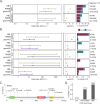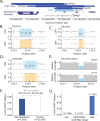This is a preprint.
Germline pathogenic variants in 786 neuroblastoma patients
- PMID: 36747619
- PMCID: PMC9901064
- DOI: 10.1101/2023.01.23.23284864
Germline pathogenic variants in 786 neuroblastoma patients
Update in
-
Germline pathogenic variants in neuroblastoma patients are enriched in BARD1 and predict worse survival.J Natl Cancer Inst. 2024 Jan 10;116(1):149-159. doi: 10.1093/jnci/djad183. J Natl Cancer Inst. 2024. PMID: 37688579 Free PMC article.
Abstract
Importance: Neuroblastoma accounts for 12% of childhood cancer deaths. The genetic contribution of rare pathogenic germline variation in patients without a family history remains unclear.
Objective: To define the prevalence, spectrum, and clinical significance of pathogenic germline variation in cancer predisposition genes (CPGs) in neuroblastoma patients.
Design setting and participants: Germline DNA sequencing was performed on the peripheral blood from 786 neuroblastoma patients unselected for family history. Rare variants mapping to CPGs were evaluated for pathogenicity and the percentage of cases harboring pathogenic (P) or likely pathogenic (LP) variants was quantified. The frequency of CPG P-LP variants in neuroblastoma cases was compared to two distinct cancer-free control cohorts to assess enrichment. Matched tumor DNA sequencing was evaluated for "second hits" at CPGs and germline DNA array data from 5,585 neuroblastoma cases and 23,505 cancer-free control children was analyzed to identify rare germline copy number variants (CNVs) affecting genes with an excess burden of P-LP variants in neuroblastoma. Neuroblastoma patients with germline P-LP variants were compared to those without P-LP variants to test for association with clinical characteristics, tumor features, and patient survival.
Main outcomes and measures: Rare variant prevalence, pathogenicity, enrichment, and association with clinical characteristics, tumor features, and patient survival.
Results: We observed 116 P-LP variants in CPGs involving 13.9% (109/786) of patients, representing a significant excess burden of P-LP variants compared to controls (9.1%; P = 5.14 × 10-5, Odds Ratio: 1.60, 95% confidence interval: 1.27-2.00). BARD1 harbored the most significant burden of P-LP variants compared to controls (1.0% vs. 0.03%; P = 8.18 × 10-7; Odds Ratio: 32.30, 95% confidence interval: 6.44-310.35). Rare germline CNVs disrupting BARD1 were also identified in neuroblastoma patients (0.05%) but absent in controls (P = 7.08 × 10-3; Odds Ratio: 29.47, 95% confidence interval: 1.52 - 570.70). Overall, P-LP variants in DNA repair genes in this study were enriched in cases compared to controls (8.1% vs. 5.7%; P = 0.01; Odds Ratio: 1.45, 95% confidence interval: 1.08-1.92). Neuroblastoma patients harboring a germline P-LP variant had a worse overall survival when compared to patients without P-LP variants (P = 8.6 × 10-3), and this remained significant in a multivariate Cox proportional-hazards model (P = 0.01).
Conclusions and relevance: Neuroblastoma patients harboring germline P-LP variants in CPGs have worse overall survival and BARD1 is an important predisposition gene affected by both common and rare pathogenic variation. Germline sequencing should be performed for all neuroblastoma patients at diagnosis to inform genetic counseling and support future longitudinal and mechanistic studies. Patients with a germline P-LP variant should be closely monitored, regardless of risk group assignment.
Keywords: DNA repair; Neuroblastoma; genetic predisposition; germline; survival.
Figures




References
-
- Matthay KK, Maris JM, Schleiermacher G, et al. Neuroblastoma. Nature Reviews Disease Primers. 2016;2(1):16078. - PubMed
-
- Friedman DL, Kadan-Lottick NS, Whitton J, et al. Increased risk of cancer among siblings of long-term childhood cancer survivors: a report from the childhood cancer survivor study. Cancer epidemiology, biomarkers & prevention : a publication of the American Association for Cancer Research, cosponsored by the American Society of Preventive Oncology. 2005;14(8):1922–1927. - PubMed
Publication types
Grants and funding
LinkOut - more resources
Full Text Sources
Research Materials
